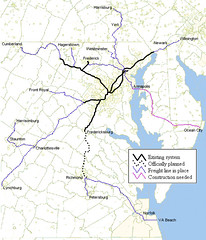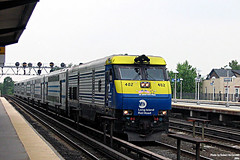A not quite perfect national railroad transportation plan
comes from Andy Kunz. See "NEW DEAL NATIONAL RAIL PLAN 2009" from the Urban Design website.
I think it's a good start, with nice vision, but not perfect. He proposes three levels of support for rail: a national high speed system; (2) regional heavy rail; and local light rail and streetcars.
There are (at least) four levels. What he calls regional is more "metropolitan" or subregional. At least I don't think of the WMATA subway system (the image used in his presentation to illustrate this category) as a full regional rail system. The DC subway system is part of a regional transportation system, but incomplete on its own.
A regional railroad system in our area should provide service to Virginia Beach on the south (VA) to Wilmington (DE) and Harrisburg (PA) on the north, and throughout VA and WV on the west, and throughout southern and eastern Maryland. That's a much much much greater span than the WMATA subway lines.
BeyondDC's older railroad concept vision map shows how regional rail service is broader and deeper than a metropolitan-based service such as the WMATA subway system. In places like Paris and London there is much greater in-city railroad service overlap of the subway and tram lines. In Manhattan, there is limited railroad service other than at Penn Station and Grand Central Station. In DC, railroad service is limited as well, at Union Station and at L'Enfant Plaza.

Image courtesy of BeyondDC.
National high speed railroads and regional higher speed and lower speed railroads are equally deserving of being considered separately and simultaneously with metropolitan transit networks. See these past blog entries:
-- The (Meta) Regional Transit Network and transportation "vision" maps
-- The DC Transit Network
-- Transit for Howard County and Rethinking Sprawl and Refocusing upon the Core
-- A regional railroad passenger transportation vision for DC, MD, VA, WV and parts of PA
2. It's a waste of time to talk about retooling car companies as transit vehicle manufacturers. Let new companies develop. Fund them. Workers at other companies can go apply for jobs there. The auto companies haven't demonstrated that they are the companies you want to build transit vehicles. Acknowledge that and move on.
Better that you would have recommended rebuilding the rail systems and vehicle manufacturing infrastructure, building that capacity and skill here, without mucking it up with the auto industries. There's nothing to prevent GE from restarting their "apparatus" division and I have no problem with govt. assistance to move that forward. (The assets of the old Budd Company ended up with Bombardier.)
Similarly, I have written that DC, MD, and VA should license, just like Oregon Iron Works did, the ability to manufacture Inekon streetcar vehicles, and set up a plant in the Ivy City Train yard in DC, and build cars for use in our region, which if all the plans were built out, would require 100s of vehicle sets.
See:
-- DC as a center of streetcar manufacturing excellence?
Note that General Motors used to manufacture locomotives, but they sold the division, which is now operating as an independent, and successful, company, Electro Motive.

Electro Motive locomotive on the Long Island Railroad. Image: The Bergen Network.
Labels: infrastructure, railroads, transportation planning



0 Comments:
Post a Comment
<< Home